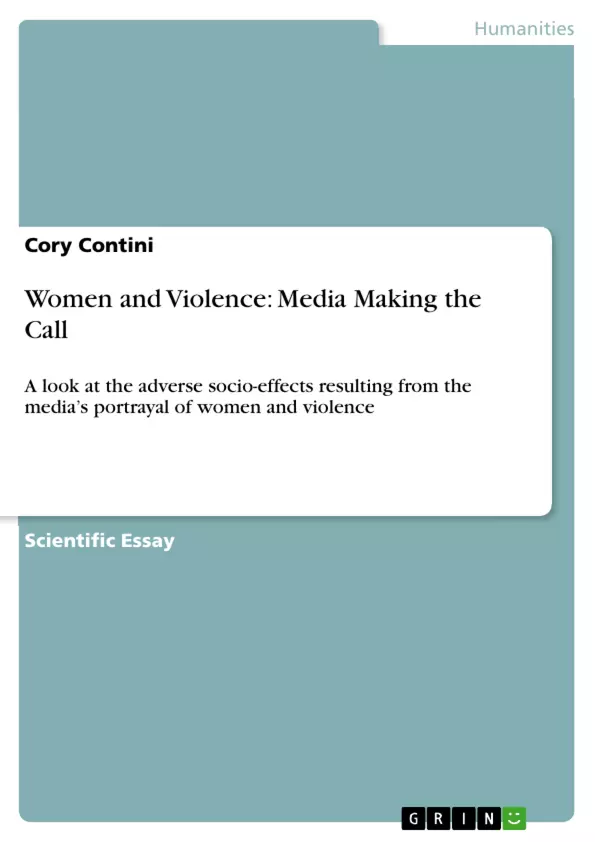Through extensive research, this paper concludes that often times it is not the details of the crime that determine whether a story will receive news coverage, rather, it is the woman’s age, race, nationality, class, or even appearance, that determines it; and that furthermore, this portrayal of women in the media is detrimental for women in society.
Table of Contents
- The Portrayal of Women in the News
- News Coverage and Societal Perceptions
- Imperatives Guiding Crime News
- Victim-Blaming and Media Portrayal
- Media Focus and Societal Fear
Objectives and Key Themes
This paper aims to analyze how the media's portrayal of women and violence contributes to adverse socio-effects. It argues that the selection of stories for news coverage is often biased, prioritizing certain victim demographics over others and perpetuating harmful stereotypes.
- Media Bias in Reporting Violence Against Women
- The Influence of Victim Demographics on News Coverage
- The Role of Sensationalism in Crime Reporting
- Victim-Blaming and its Consequences
- The Impact of Media Portrayal on Public Perception and Fear
Chapter Summaries
The Portrayal of Women in the News: This chapter introduces the central argument: that media coverage of violence against women is biased, favoring certain victim profiles (e.g., white, upper-class women) over others. It establishes the importance of examining this bias, highlighting its contribution to societal perceptions of women and crime. The chapter lays the groundwork for further investigation into the factors influencing news selection and their subsequent impact. The author acknowledges limitations in the scope of the research, focusing specifically on the media's role and excluding the influence of family advocacy.
News Coverage and Societal Perceptions: This section delves into the concept of "newsworthiness" and how subjective judgments by journalists and editors shape what is deemed newsworthy. It introduces the idea of a "white lens" in news delivery, suggesting that media professionals tend to prioritize stories involving victims they can more easily relate to. The chapter explores how this bias reinforces societal perceptions and affects public understanding of violence against women.
Imperatives Guiding Crime News: This chapter analyzes the eight professional imperatives (immediacy, dramatization, personalization, simplification, titillation, conventionalism, structured access, and novelty) that often guide crime news reporting. It shows how these imperatives can lead to a focus on sensationalism over factual accuracy and meaningful context. The chapter connects this to the commercial nature of the media, suggesting a drive for profit influences the selection and presentation of news stories.
Victim-Blaming and Media Portrayal: This chapter explores the phenomenon of victim-blaming in media portrayals of violence against women. It highlights factors that contribute to this, such as the victim's relationship with the assailant, the presence or absence of a weapon, and the victim's race and socioeconomic status. The chapter connects this to the disproportionate negative impact on women of color, who are often portrayed as less credible victims. The chapter underscores how this blaming exacerbates the suffering of victims.
Media Focus and Societal Fear: The final substantive chapter presents findings from Marian Meyers' study on media coverage of violence against women in Atlanta, Georgia. This research reveals a significant bias towards featuring white, upper-middle-class victims, disproportionate to actual crime statistics. The chapter connects these findings to elevated levels of fear among women, highlighting the discrepancy between media portrayals and reality.
Keywords
Media representation, violence against women, news bias, victim demographics, sensationalism, victim-blaming, societal perceptions, fear, crime reporting, newsworthiness.
Frequently Asked Questions: Media Portrayal of Women and Violence
What is the main focus of this document?
This document comprehensively analyzes how media portrayals of women and violence contribute to negative societal effects. It examines media bias in reporting, the influence of victim demographics on news coverage, the role of sensationalism, victim-blaming, and the impact on public perception and fear.
What are the key themes explored in the document?
The key themes include media bias in reporting violence against women, the influence of victim demographics on news selection, the role of sensationalism in crime reporting, victim-blaming and its consequences, and the impact of media portrayals on public perception and fear of crime.
What are the chapter summaries?
The document provides summaries for each chapter. The first chapter introduces the central argument of media bias favoring certain victim profiles. The second explores how subjective judgments in news selection shape what is considered newsworthy. The third analyzes the imperatives (immediacy, dramatization, etc.) guiding crime news reporting and their potential for sensationalism. The fourth examines victim-blaming in media portrayals and its disproportionate impact on women of color. The final chapter presents research findings on media bias in Atlanta, Georgia, and its connection to elevated fear among women.
What are the objectives of this analysis?
The main objective is to analyze how the media's portrayal of women and violence contributes to adverse socio-effects. It aims to demonstrate that news coverage is often biased, prioritizing certain victim demographics and perpetuating harmful stereotypes.
What are the key takeaways from the research presented?
A significant bias exists in media coverage of violence against women, favoring certain victim profiles (often white, upper-class women) and disproportionately impacting women of color. This bias influences societal perceptions, reinforces harmful stereotypes, and contributes to heightened fear among women, often misrepresenting the actual crime statistics.
What are the limitations of the research acknowledged in the document?
The research specifically focuses on the media's role in shaping perceptions of violence against women and excludes other influential factors, such as the influence of family advocacy.
What are the keywords associated with this analysis?
Key words include: Media representation, violence against women, news bias, victim demographics, sensationalism, victim-blaming, societal perceptions, fear, crime reporting, and newsworthiness.
What specific examples or studies are mentioned?
The analysis references a study by Marian Meyers on media coverage of violence against women in Atlanta, Georgia, which revealed a significant bias towards featuring white, upper-middle-class victims.
- Quote paper
- Cory Contini (Author), 2009, Women and Violence: Media Making the Call, Munich, GRIN Verlag, https://www.grin.com/document/211154



